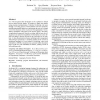203
click to vote
POPL
2007
ACM
16 years 1 months ago
2007
ACM
This paper contributes to the development of techniques for the modular proof of programs that include concurrent algorithms. We present a proof of a non-blocking concurrent algor...
190
Voted
POPL
2007
ACM
16 years 1 months ago
2007
ACM
It is well recognized that JavaScript can be exploited to launch browser-based security attacks. We propose to battle such attacks using program instrumentation. Untrusted JavaScr...
198
click to vote
POPL
2007
ACM
16 years 1 months ago
2007
ACM
We present a formal model of memory that both captures the lowlevel features of C's pointers and memory, and that forms the basis for an expressive implementation of separati...
214
Voted
POPL
2008
ACM
16 years 1 months ago
2008
ACM
Relevance heuristics allow us to tailor a program analysis to a particular property to be verified. This in turn makes it possible to improve the precision of the analysis where n...
227
Voted
POPL
2008
ACM
16 years 1 months ago
2008
ACM
Conventional specifications for object-oriented (OO) programs must adhere to behavioral subtyping in support of class inheritance and method overriding. However, this requirement ...
216
Voted
POPL
2008
ACM
16 years 1 months ago
2008
ACM
alyses are concerned with precise abstractions of the heap to capture detailed structural properties. To do so, they need to build and decompose summaries of disjoint memory regio...
181
Voted
POPL
2008
ACM
16 years 1 months ago
2008
ACM
When scripts in untyped languages grow into large programs, maintaining them becomes difficult. A lack of types in typical scripting languages means that programmers must (re)disc...
233
click to vote
PLDI
2009
ACM
16 years 1 months ago
2009
ACM
High-level languages are growing in popularity. However, decades of C software development have produced large libraries of fast, timetested, meritorious code that are impractical...
207
Voted
ICFP
2009
ACM
16 years 1 months ago
2009
ACM
Purely functional programs should run well on parallel hardware because of the absence of side effects, but it has proved hard to realise this potential in practice. Plenty of pap...
WWW
2007
ACM
16 years 1 months ago
2007
ACM
As the data and ontology layers of the Semantic Web stack have achieved a certain level of maturity in standard recommendations such as RDF and OWL, the current focus lies on two ...


